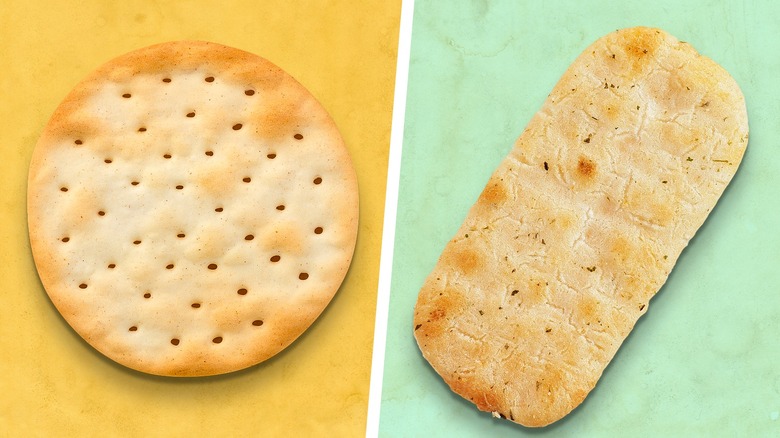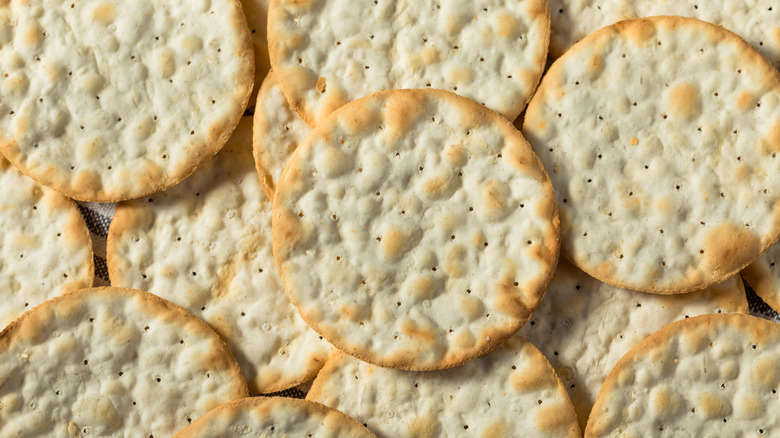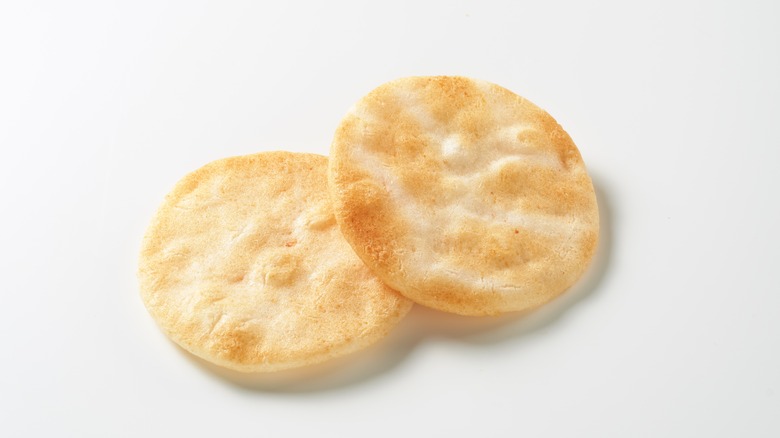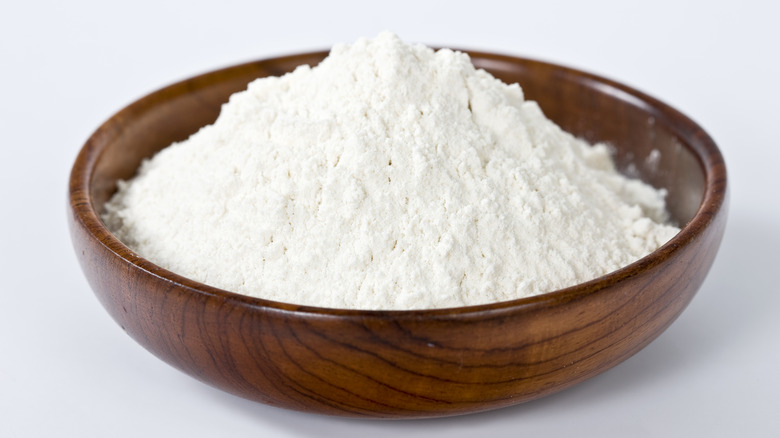What's The Difference Between Water Crackers And Rice Crackers?
There are many types of crackers to upgrade your charcuterie board, to serve with chicken or tuna salad, or to just eat on their own as a simple snack. Out of the many varieties out there, water and rice crackers are both good options if you prefer thin crackers with a nice crunch. It's always good to have a box of crackers (or two) in your pantry, but you should also know the differences, especially when serving them to guests. At a glance, water and rice crackers look similar but there are subtle differences that lie in their origins, which ingredients go into a batch, and the resulting taste and texture.
Water crackers are often served with cheese, and you might have heard of the popular brand Carr's Table Water Crackers. These are similar to those saltine crackers you might pair with soups or snack on when you're sick, made with flour and other additions like salt. They can be bland, which is why they work well with cheese and other flavor-rich foods. Rice crackers have Asian origins and are made with rice (hence the name) instead of the traditional wheat flour in water crackers.
What are water crackers?
Water crackers are popular here in the U.S., and are commonly served with cheeses and cured meats on a charcuterie board. The baked snacks might be referred to as water biscuits in the United Kingdom, and they've been popular dating back to the 1800s when they were used as sustenance on sea voyages because they didn't spoil. The crackers are traditionally made of only wheat and water, however, oil, salt, and other additives are found in many packaged varieties. They're thin and light but still have a crunchy texture.
When it comes to the flavor, some varieties can be bland, but expect subtle levels of toastiness and saltiness. There are also flavored water crackers, such as garlic herb, multi grain, and toasted sesame if you like to eat something that packs more punch. Other than letting you serve and eat Brie cheese like an expert, your favorite water crackers also work as the prefect dippers with a classic pimento cheese, piled with fruit jams and spreads, or for a healthier alternative to potato chips (provided you can tolerate wheat).
What are rice crackers?
While water crackers have somewhat recent origins in the U.K. and U.S., rice crackers date back thousands of years to China and later Japan. There are many varieties of rice crackers from both cuisines. Some types are wrapped in seaweed or encrusted with sesame seeds, but we're sticking to the packaged rice crackers that compare to water crackers here. Rice crackers are made with rice flour, oils or water, and likely some sort of preservative. They're on the crunchier side just like their water cracker counterparts. (In case you're wondering, these crackers are different from rice cakes, which are made from the grain and water and are much larger and puffier.)
Rice crackers can taste savory or salty. Depending on what brand or variety you pick up from the store, they might have soy or sesame notes. There are also varieties that have wasabi or other spicy flavors from brands like Ka-Me. Generally speaking, you can enjoy rice crackers basically in the same ways as water crackers. Eat them on their own or with a cold and savory dip like Tasting Table's whipped feta dip.
Water crackers are made with wheat flour, but rice crackers are not
The biggest difference between water and rice crackers is the core ingredient. Like we've said, water crackers are typically made with wheat flour. The base is a basic dough of flour, water, and those other ingredients we mentioned at the top. Some varieties might use whole grains or other seeds, but you can expect there to be some sort of wheat involved. One exception would be a specifically gluten-free option made with tapioca flour instead.
In comparison, rice crackers are made of a dough consisting of some type of rice. Some brands use jasmine rice, but it can vary. It might be bleached or unbleached rice flour combined with oils or waters like the dough of water crackers, and you might find sesame seeds or other Asian-inspired ingredients mixed in. Since they're made with rice rather than wheat, most brands don't contain gluten and may be better suited to those with intolerances or preferences.



